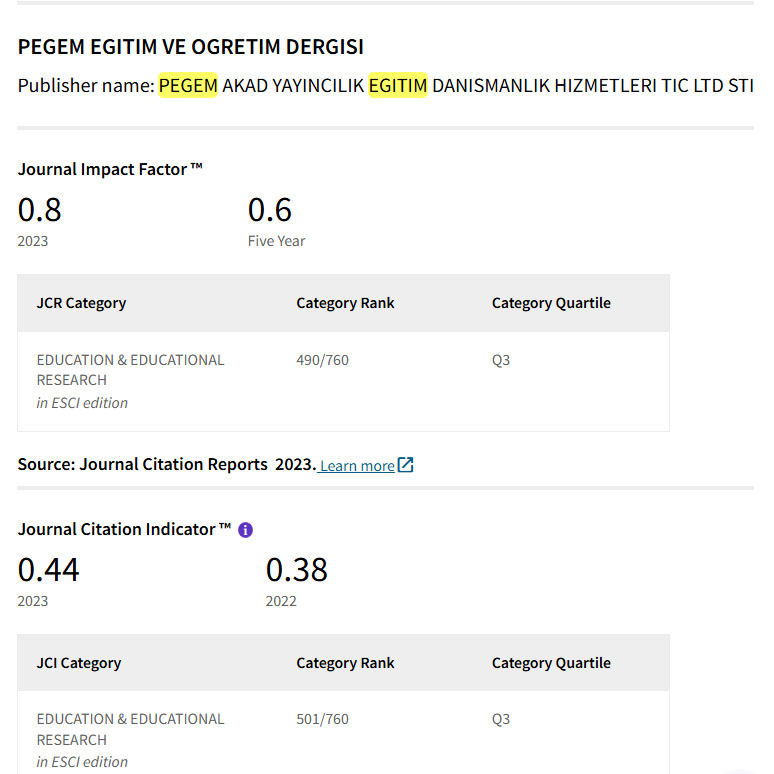Scrutinizing university students’ online learning readiness and learning achievement
DOI:
https://doi.org/10.47750/pegegog.12.03.29Keywords:
Online learning readiness, learning achievement, university studentsAbstract
This study aims to determine the level of student online learning readiness (OLR) and determine its correlation with students’ learning achievement (LA). To achieve this goal, a mixed-method with a correlation design was applied. The data was taken by administering OLR questionnaire, holding interview, and documenting students’ final scores in Islamic philosophy courses. This score in this study was considered as students’ LA. 56 first-semester students from a public university in West Nusa Tenggara, Indonesia became the participants. The results showed that the majority of students were ready with improvement for joining online learning (OL) as indicated by the average OLR score of 3.65. However, students mentioned some challenges during OL such as unstable internet connection, unconducive learning environment, and inability to be a multitasker. This study revealed that students’ OLR had a very strong correlation to LA as shown by r=0.085, sig=0.000. Henceforth, this study implied the need for teachers and educational institutions to help students to be ready to join the new learning system. However, this study promotes improvement for future investigation because of its limited variables and samples.
Downloads
References
Agustina, D., Matra, S. D., & Karimah, S. (2020). Challenges of having online learning activities: University students’ perspectives. iNELTAL Conference Proceedings.
Andresen, M. A. (2009). Asynchronous discussion forums: Success factors, outcomes, assessments, and limitations. Technology & Society, 12(1), 249–257.
Aydm, C. H. & Tasci, D. (2005). Measuring readiness for e-Learning: reflections from an emerging country. Educational Technology and Society, 8(4), 244-257.
Bain, Y. (2006). Does online discussion foster collaboration? Views from the literature. PICTAL Conference Presentation, 1 (2), 1-11.
Coman, C., Meses, L., Stanciu, C., & Bularca, M. C. (2020). Online teaching and learning in higher education during the coronavirus pandemic: Students’ perspective. Sustainability, 12. https://doi.org/10.3390/su122410367
Dangol, R., & Shrestha, M. (2019). Learning readiness and educational achievement among school students. International Journal of Indian Psychology, 7(2), 467-476.
Ellis, A. R., Goodyear, P., & Prosser, M. (2007). The university student experience of face-to-face and online discussions: Coherence, reflection, and meaning. Research in Learning Technology, 15(1), 83–97.
Filgona, J., Sakiyo, J. Gwany, D. M., & Okoronka, A. U. (2020). Motivation in Learning. Asian Journal of Education and Social Studies, 10(4): 16-37. https://doi.org/10.9734/AJESS/2020/v10i430273
Jamal, S. (2020). Analisis kesiapan pembelajaran e-learning saat pandemi covid-19 di SMK Negeri 1 Tambelangan. Paedagoria, 11(2), 149-154. https://doi.org/10.31764
Krasnova, T., & Ananjev, A. (2015). Students’ perception of learning in the online discussion environment. Mediterranean Journal of Social Sciences, 6(6), https://doi.org/10.5901/mjss.2015.v6n6s1p202.
Kumar, V. & Nanda, J. (2018). Social media in higher education: A framework for continuous engagement. International journal of information and communication technology education: An official publication of the Information Resources Management Association, 15(1), 109-120. https://doi.org/10.4018/IJICTE.2019010108
Lemoine, P. A., Waller, R. E., Garretson, C. J., & Richardson, M. D. (2020). Examining technology for teaching and learning. Journal of Education and Development, 4(2). https://doi.org/10.20849/jed.v4i2.781
Meghanatan, J. (2016). Assortativity analysis of real-world network graphs based on centrality metrics. Computer and Information Science, 9(3), 7-25. https://doi.org/10.5539/cis.v9n3p7
Morgan, K. (2006). Ground rules in online discussions: Help or hindrance?. University of Wyoming, 6, 285-305.
Nugroho, P. T. Y., Hidayati, H., & Suwawi, D. D. J. (2014). Evaluasi e-learning readiness Universitas Telkom dengan menggunakan McKinsey 7s Model. E-Proceeding of Engineering, 1(1), 647–668.
Octaberlina, L. R. & Muslimin, A. I. (2021). Online learning: Students’ autonomy and attitudes. Xlinguae, 14(1), 49-61. https://doi.org/10.18355/XL.2021.14.01.04
Putri, R. S., Purwanto, A., Pramono, R., Asbari, M. Wijayanti, L. M., & Hyun, C. C. (2020). Impact of the COVID-19 pandemic on online home learning: An explorative study of primary schools in Indonesia. International Journal of Advanced Science and Technology, 29(5), 4809 – 4818.
Rohmah, F. (2016). Analisis kesiapan sekolah terhadap penerapan pembelajaran online (e-learning) di SMA Negeri 1 Kutowinangun. Skripsi Program Studi Pendidikan Teknik Informatika. Universitas Negeri Yogyakarta, Yogyakarta, Indonesia.
Sadikin, A. & Hamidah, A. (2020). Pembelajaran daring di tengah wabah covid-19. BIODIK: Jurnal Ilmiah Pendidikan Biologi, 6(2), 214-224.
Setyoningsih, S. (2015). E-learning: Pembelajaran interaktif berbasis teknologi informasi. ELEMENTARY: Islamic Teacher Journal, 3(1), 48-51.
Torun, E. K. (2020). Online distance learning in higher education: E-learning readiness as a predictor of academic achievement. Open Praxis, 12 (2), 191–208.
Triastuti, N. J. (2016). The relationship of self-directed learning readiness and learning motivation towards learning achievement of first year medical students. The 2nd International Conference on Science, Technology, and Humanity, 1-16.
Vosloo, S. & Belle, J. P. (2004). E-goverment and e-readiness of non profit organization in the Western Cape, South America. Retrieved from https://www.westerncape.gov.za/se rvice/non-profit organisationsregistration-and-funding
Watkins, R., Dou, L., & Don, T. (2003). Assessing readiness for e- learning. Performance Improvement Quarterly,17(4), 66-79.
Winarso. (2016). Assessing the readiness of student learning activity and learning outcome. Jurnal Penderahan, 10(2), 81-94. https://doi.org/10.13170/jp.10.2.5246
Yuzulia, I. (2021). The challenges of online learning during pandemic: Students’ voice. Wanastra : Jurnal Bahasa dan Sastra, 13(1). https://doi.org/10.31294/w.v12i1
Zhang, D., Zhao, J., Zhou, L., & Nunamaker, J. F. (2004). Can e-learning replace classroom learning. Communication of the ACM, 47(5). https://doi.org/10.1145/986213.986216
Downloads
Published
How to Cite
Issue
Section
License
Copyright (c) 2022 Pegem Journal of Education and Instruction

This work is licensed under a Creative Commons Attribution-NonCommercial 4.0 International License.
Attribution — You must give appropriate credit, provide a link to the license, and indicate if changes were made. You may do so in any reasonable manner, but not in any way that suggests the licensor endorses you or your use.
NonCommercial — You may not use the material for commercial purposes.
No additional restrictions — You may not apply legal terms or technological measures that legally restrict others from doing anything the license permits.



